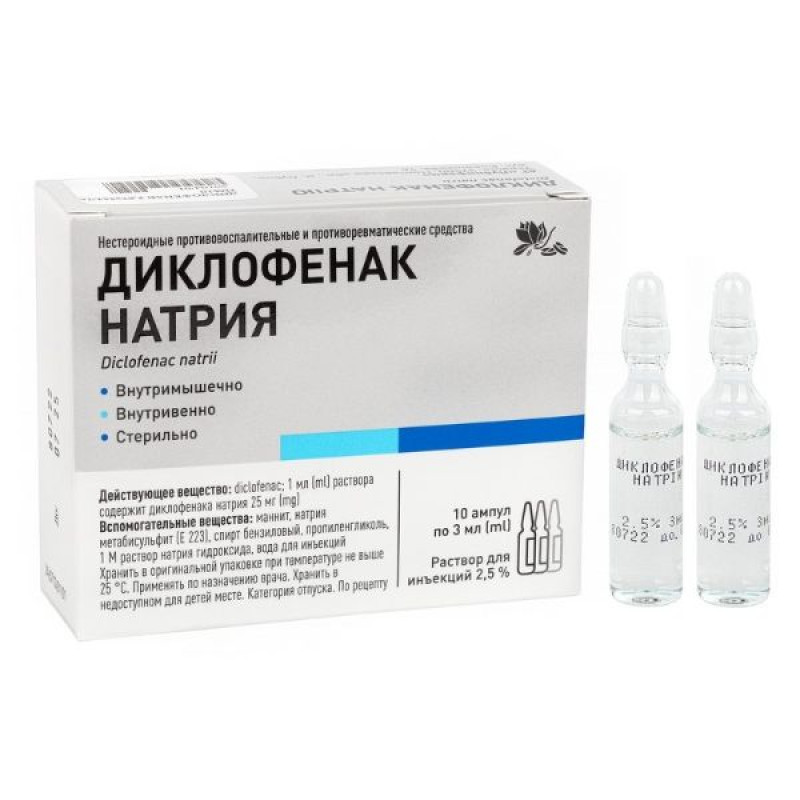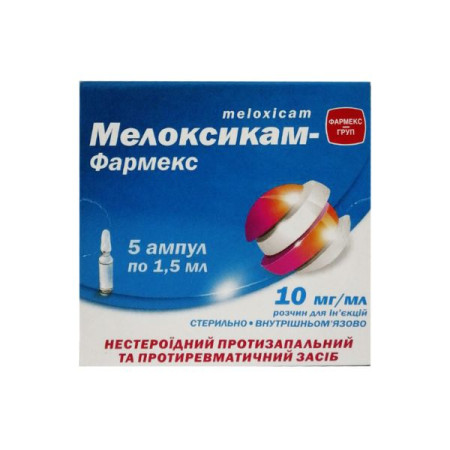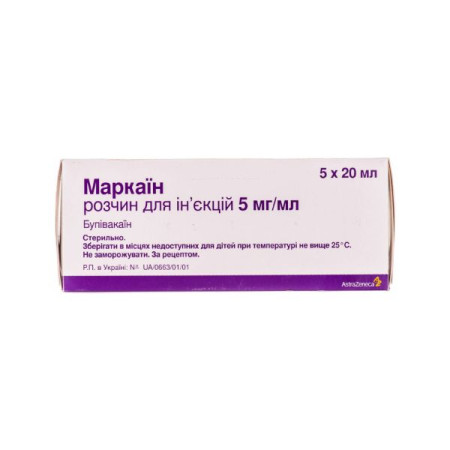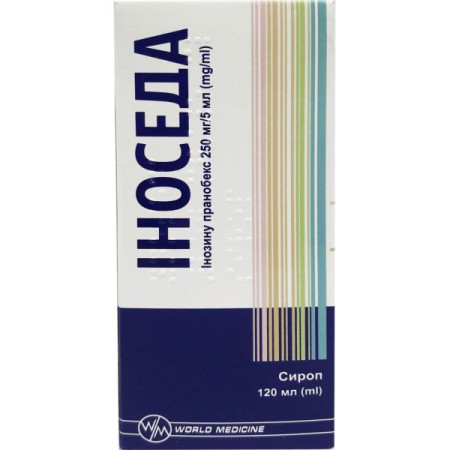Diclofenac solution for injection 2.5% 3 ml No. 10
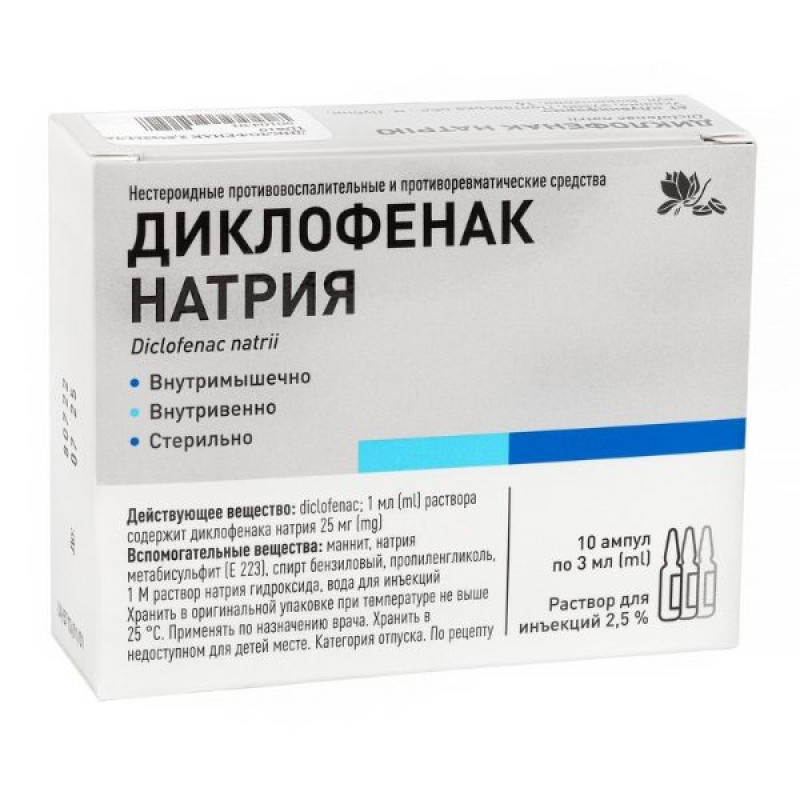
Instructions Diclofenac solution for injection 2.5% 3 ml No. 10
Composition
active ingredient: diclofenac;
1 ml of solution contains diclofenac sodium 25 mg;
Excipients: mannitol, sodium metabisulfite (E 223), benzyl alcohol, propylene glycol, 1 M sodium hydroxide solution, water for injections.
Dosage form
Solution for injection.
Main physicochemical properties: transparent, colorless or with a faint yellowish tinge solution with a slight specific odor of benzyl alcohol, practically free from particles.
Pharmacotherapeutic group
Nonsteroidal anti-inflammatory and antirheumatic drugs. Acetic acid derivatives and related compounds. ATX code M01A B05.
Pharmacological properties
Pharmacodynamics.
Diclofenac sodium is a nonsteroidal compound with pronounced antirheumatic, anti-inflammatory, analgesic and antipyretic properties. Inhibition of prostaglandin biosynthesis, which has been demonstrated in experiments, is considered to be the main mechanism of its action. Prostaglandins play an important role in the occurrence of inflammation, pain and fever.
In rheumatic diseases, the anti-inflammatory and analgesic properties of the drug result in a clinical response characterized by a marked disappearance of signs and symptoms: pain at rest and during movement, morning stiffness and joint swelling, as well as a noticeable improvement in function.
Diclofenac is able to enhance the pronounced analgesic effect on moderate and severe pain of non-rheumatic origin within 15-30 minutes.
Diclofenac has also demonstrated a significant effect on migraine attacks.
In post-traumatic and postoperative conditions with inflammation, diclofenac quickly relieves spontaneous pain and pain during movement and reduces swelling caused by inflammation and wounds.
If the drug is used simultaneously with opioid analgesics to relieve postoperative pain, diclofenac significantly reduces their need.
Diclofenac Sodium, solution for injection in ampoules is especially necessary for the initiation of treatment of inflammatory and degenerative rheumatic diseases and pain due to inflammation of non-rheumatic origin.
Pharmacokinetics.
Absorption: After administration of 75 mg diclofenac by intramuscular injection, absorption begins immediately and mean maximum plasma concentrations of approximately 2.5 μg/ml (8 μmol/l) are reached after approximately 20 minutes. The extent of absorption may be linearly proportional to the dose.
When 75 mg diclofenac is administered by intravenous infusion over 2 hours, the mean maximum plasma concentrations are approximately 1.9 μg/ml (5.9 μmol/l). Shorter infusion times lead to higher maximum plasma concentrations, while longer infusions lead to concentrations proportional to the infusion rate after 3-4 hours. After intramuscular injection or ingestion of gastro-resistant tablets or suppositories, plasma concentrations decline rapidly after reaching peak levels.
The area under the concentration-time curve after intramuscular or intravenous administration is approximately twice as large as after oral or rectal administration, since approximately half of the active substance is metabolized during the first passage through the liver (the "first-pass effect") if the drug is administered orally or rectally.
Pharmacokinetic properties do not change after repeated administration. If the recommended dosing intervals are observed, drug accumulation does not occur.
Distribution: 99.7% of diclofenac is bound to serum proteins, mainly albumin (99.4%). The apparent volume of distribution is 0.12-0.17 l/kg.
Diclofenac penetrates into the synovial fluid, where maximum concentrations are reached 2-4 hours after peak plasma levels. The elimination half-life from synovial fluid was 3 to 6 hours. 2 hours after peak plasma levels, diclofenac concentrations in synovial fluid exceed those in plasma and remain higher for 12 hours.
Biotransformation. The biotransformation of diclofenac occurs partly by glucuronidation of the intact molecule, but mainly by single and multiple hydroxylation and methoxylation, leading to the formation of several phenolic metabolites, most of which are converted to glucuronide conjugates. Two of these phenolic metabolites are biologically active, but their activity is much less pronounced than that of diclofenac.
Approximately 60% of the administered dose is excreted in the urine as the glucuronide conjugate of the intact molecule and as metabolites, most of which are also converted to glucuronide conjugates. Less than 1% is excreted as unchanged substance. The remainder of the dose is eliminated as metabolites via the bile and feces.
Special patient groups.
No age-related differences in absorption, metabolism, or excretion of the drug were observed. However, in some elderly patients, a 15-minute intravenous infusion resulted in plasma concentrations that were 50% higher than those observed in young healthy subjects.
In patients with renal impairment, no accumulation of the active substance is expected when the usual dosage regimen is followed. In conditions of creatinine clearance < 10 ml/min, the plasma levels of hydroxy metabolites at steady state are approximately 4 times higher than in healthy patients.
Thus, metabolites are ultimately excreted in the bile.
In patients with chronic hepatitis or non-decompensated cirrhosis, the kinetics and metabolism of diclofenac are the same as in healthy patients.
Indication
The drug, when administered intramuscularly, is intended for the treatment of:
– inflammatory and degenerative forms of rheumatism, rheumatoid arthritis, ankylosing spondylitis, osteoarthritis, spondyloarthritis, vertebral pain syndrome, non-articular rheumatism;
– acute attacks of gout;
– renal and biliary colic;
– pain and swelling after injuries and surgeries;
– severe migraine attacks.
The drug, when administered as an intravenous infusion, is intended for the treatment or prevention of postoperative pain.
Contraindication
– Hypersensitivity to diclofenac, sodium metabisulfite or any other component of the drug.
– History of gastrointestinal bleeding or perforation related to previous treatment with nonsteroidal anti-inflammatory drugs (NSAIDs).
– Active ulcer/bleeding or history of recurrent ulcer/bleeding (two or more separate episodes of established ulceration or bleeding).
- Like other NSAIDs, diclofenac is contraindicated in patients in whom the use of ibuprofen, acetylsalicylic acid or other nonsteroidal anti-inflammatory drugs provokes attacks of bronchial asthma, angioedema, urticaria, acute rhinitis/nasal polyps, bronchospasm or other allergic reactions.
– Inflammatory bowel diseases (such as Crohn's disease or ulcerative colitis).
– Acute stomach or intestinal ulcer; gastrointestinal bleeding or perforation.
– Liver failure (Child–Pugh class C, cirrhosis and ascites).
– Renal failure (creatinine clearance < 30 ml/min).
– Congestive heart failure (NYHA II-IV).
– High risk of developing postoperative bleeding, blood clotting disorders, hemostasis disorders, hematopoietic disorders, or cerebrovascular bleeding.
– Treatment of perioperative pain during coronary artery bypass grafting (or the use of a cardiopulmonary bypass machine).
– Ischemic heart disease in patients with angina pectoris or previous myocardial infarction.
– Cerebrovascular disease in patients who have had a stroke or have episodes of transient ischemic attacks.
– Peripheral artery disease.
– In this dosage form, the drug is contraindicated in children.
– III trimester of pregnancy.
For intravenous use only.
– Concomitant use of NSAIDs or anticoagulants (including low-dose heparin).
– History of hemorrhagic diathesis, confirmed or suspected cerebrovascular bleeding in history.
– Surgeries associated with a high risk of bleeding.
– History of bronchial asthma.
– Moderate or severe renal impairment (serum creatinine more than 160 μmol/l).
– Hypovolemia or dehydration from any cause.
Interaction with other medicinal products and other types of interactions
The following are interactions observed with the use of diclofenac sodium solution for injection and/or other diclofenac dosage forms.
Lithium: Diclofenac may increase plasma lithium concentrations when used concomitantly. Monitoring of serum lithium levels is recommended.
Digoxin: Diclofenac may increase plasma digoxin concentrations when used concomitantly. Monitoring of serum digoxin levels is recommended.
Drugs known to cause hyperkalemia: Concomitant treatment with potassium-sparing diuretics, cyclosporine, tacrolimus, or trimethoprim may be associated with increases in serum potassium, and patients should be monitored more frequently.
Other NSAIDs, including selective cyclooxygenase-2 inhibitors, and corticosteroids. Concomitant use of diclofenac and other systemic NSAIDs or corticosteroids may increase the risk of gastrointestinal bleeding or ulceration. The concomitant use of two or more NSAIDs should be avoided.
Anticoagulants and antithrombotic agents. Caution is advised as concomitant use may increase the risk of bleeding. Although clinical studies do not indicate an effect of diclofenac on the activity of anticoagulants, there is some evidence of an increased risk of bleeding in patients receiving diclofenac and anticoagulants concomitantly. Therefore, careful monitoring of patients receiving diclofenac and anticoagulants concomitantly is recommended and, if necessary, adjustment of the anticoagulant dosage. Like other NSAIDs, diclofenac in high doses may transiently inhibit platelet aggregation.
Selective serotonin reuptake inhibitors (SSRIs): Concomitant use of systemic NSAIDs and SSRIs may increase the risk of gastrointestinal bleeding.
Antidiabetic agents. Clinical studies have shown that diclofenac can be used together with oral antidiabetic agents without affecting their clinical effect. However, isolated cases of both hypoglycemic and hyperglycemic effects have been reported, requiring a change in the dosage of antidiabetic agents during treatment with diclofenac. In such cases, monitoring of blood glucose levels is necessary as a precautionary measure during concomitant therapy.
There are also isolated reports of metabolic acidosis with concomitant use with diclofenac, especially in patients with pre-existing renal impairment.
Colestipol and cholestyramine. Concomitant administration of diclofenac and colestipol or cholestyramine may delay or reduce the absorption of diclofenac by approximately 30% and 60%, respectively. Therefore, it is recommended that diclofenac be administered at least 1 hour before or 4-6 hours after colestipol/cholestyramine.
Drugs that induce drug-metabolizing enzymes. Drugs that induce enzymes, such as rifampicin, carbamazepine, phenytoin, St. John's wort (Hypericum perforatum), are theoretically capable of reducing diclofenac plasma concentrations.
Methotrexate. Diclofenac may inhibit the renal tubular clearance of methotrexate, leading to increased methotrexate levels. Caution is advised when NSAIDs, including diclofenac, are administered less than 24 hours before methotrexate treatment, as this may increase the blood concentration of methotrexate and increase its toxicity. Serious toxicity has been reported when methotrexate and NSAIDs, including diclofenac, were administered within 24 hours of each other. This interaction is mediated by accumulation of methotrexate as a result of impaired renal excretion in the presence of NSAIDs.
Cyclosporine: Diclofenac, like other NSAIDs, may increase the nephrotoxicity of cyclosporine through its effects on renal prostaglandins. Therefore, it should be used at lower doses than in patients not receiving cyclosporine.
Tacrolimus: The use of NSAIDs with tacrolimus increases the risk of nephrotoxicity, which may be mediated through the renal antiprostaglandin effects of NSAIDs and the calcineurin inhibitor, therefore diclofenac should be used at lower doses than in patients not taking tacrolimus.
Quinolone antibacterials. There are isolated reports of seizures that may result from the concomitant use of quinolones and NSAIDs. This may occur in patients with or without a history of epilepsy or seizures. Therefore, caution should be exercised when considering the use of quinolones in patients already receiving NSAIDs.
Phenytoin: When phenytoin is used concomitantly with diclofenac, monitoring of phenytoin plasma concentrations is recommended due to the expected increase in phenytoin exposure.
Cardiac glycosides. Concomitant use of cardiac glycosides and NSAIDs may exacerbate heart failure, reduce glomerular filtration rate, and increase plasma glycoside levels.
Mifepristone: NSAIDs should not be used for 8-12 days after mifepristone administration, as NSAIDs may reduce its effect.
Potent CYP2C9 inhibitors: Caution is required when using diclofenac concomitantly with potent CYP2C9 inhibitors (e.g. voriconazole), which may lead to a significant increase in maximum plasma concentrations and exposure to diclofenac due to inhibition of its metabolism.
Probenecid: Medicines containing probenecid may delay the elimination of diclofenac.
Application features
The use of the drug with systemic NSAIDs, including selective COX-2 inhibitors, should be avoided due to the lack of any synergistic benefit and the possibility of developing additional side effects.
Caution should be exercised when prescribing the drug to patients over 65 years of age. In particular, the lowest effective doses are recommended for elderly people with frail health and for patients with low body mass index.
As with other NSAIDs, allergic reactions, including anaphylactic/anaphylactoid reactions, may also occur rarely without prior exposure to diclofenac. Hypersensitivity reactions may also progress to Kounis syndrome, a serious allergic reaction that may cause myocardial infarction. Symptoms of such reactions may include chest pain associated with an allergic reaction to diclofenac.
The use of NSAIDs, including diclofenac, is associated with an increased risk of gastrointestinal anastomotic bleeding. Close medical supervision and caution are recommended when prescribing diclofenac after gastrointestinal surgery.
The effects of NSAIDs on the kidneys include fluid retention with edema and/or hypertension. Therefore, diclofenac should be used with caution in patients with impaired cardiac function and other conditions that contribute to fluid retention. Caution should also be exercised when treating patients who are taking concomitant diuretics or ACE inhibitors or who are prone to hypovolemia.
Like other NSAIDs, diclofenac may mask signs of infection.
Injection site reactions
Injection site reactions have been reported following intramuscular administration of diclofenac, including injection site necrosis and drug embolism, also known as Nicolau's syndrome (especially after inadvertent subcutaneous injection). The instructions for intramuscular administration must be strictly followed to avoid adverse injection site reactions, which may lead to muscle weakness, muscle paralysis, hypoesthesia, drug embolism (Nicolau's syndrome) and injection site necrosis. When administering diclofenac intramuscularly, an appropriate needle and injection technique should be selected (see section 4.2).
Effects on the digestive tract
Gastrointestinal bleeding (hemorrhage, melena), ulceration or perforation, which can be fatal, have been reported with all NSAIDs, including diclofenac, and can occur at any time during treatment, with or without warning symptoms, or with a history of serious gastrointestinal events. These events are usually more severe in the elderly. If gastrointestinal bleeding or ulceration occurs in patients receiving diclofenac, the drug should be discontinued.
As with all NSAIDs, including diclofenac, close medical supervision is necessary; special care should be taken when prescribing diclofenac to patients with symptoms suggestive of gastrointestinal disorders, or with a history of gastric or intestinal ulcer, bleeding or perforation. The risk of gastrointestinal bleeding, ulceration or perforation is higher with increasing doses of NSAIDs, including diclofenac, and in patients with a history of ulcer, especially if complicated by bleeding or perforation.
Elderly patients have an increased frequency of adverse reactions when using NSAIDs, especially gastrointestinal bleeding and perforation, which can be fatal.
To reduce the risk of gastrointestinal toxicity in patients with a history of ulcer, especially those complicated by bleeding or perforation, and in elderly patients, treatment should be initiated and maintained at the lowest effective dose.
For such patients, as well as patients who require concomitant use of medicinal products containing low doses of acetylsalicylic acid (ASA) or other medicinal products that are likely to increase the risk of adverse effects on the digestive tract, the use of combination therapy with protective agents (e.g. proton pump inhibitors or misoprostol) should be considered.
Patients with a history of gastrointestinal toxicity, especially the elderly, should report any unusual abdominal symptoms (especially gastrointestinal bleeding). Caution is also required in patients receiving concomitant medications that may increase the risk of ulceration or bleeding, such as systemic corticosteroids, anticoagulants (e.g. warfarin), antithrombotic agents (e.g. acetylsalicylic acid), or selective serotonin reuptake inhibitors.
Diclofenac should be prescribed with caution to patients with a history of inflammatory bowel disease, such as Crohn's disease or non-specific ulcerative colitis, and close medical supervision and appropriate precautions should be taken, as their condition may be aggravated.
Effect on the liver
As with other NSAIDs, one or more liver enzymes may increase. During long-term treatment with the drug (tablets or suppositories), regular monitoring of liver function should be prescribed as a precautionary measure. If liver function abnormalities persist or worsen, if clinical symptoms may be associated with progressive liver disease, or if other manifestations are observed (e.g. eosinophilia, rash), the drug should be discontinued. The course of diseases such as hepatitis may occur without prodromal symptoms.
In addition to elevated liver enzymes, there have been rare reports of severe hepatic reactions, including jaundice and fulminant hepatitis, hepatic necrosis and hepatic failure, which in some cases have resulted in fatal outcomes.
Caution is necessary when diclofenac is used in patients with hepatic porphyria due to the possibility of provoking an attack.
Effects on the kidneys
Since fluid retention and edema have been reported with NSAIDs, special care should be taken in patients with impaired cardiac or renal function (including functional renal failure due to hypovolemia, nephrotic syndrome, lupus nephropathy, and decompensated cirrhosis), in patients with a history of hypertension, in the elderly, in patients receiving concomitant therapy with diuretics or drugs that significantly affect renal function, and in patients with a significant decrease in extracellular fluid volume for any reason, e.g. before or after major surgery. In such cases, monitoring of renal function is recommended as a precautionary measure. Discontinuation of therapy usually results in a return to pre-treatment status.
Due to the importance of prostaglandins in maintaining renal blood flow, prolonged treatment with high doses of NSAIDs, including diclofenac, often leads to edema and arterial hypertension.
Effects on the skin
Serious skin reactions, some of which have been fatal, including exfoliative dermatitis, Stevens-Johnson syndrome and toxic epidermal necrolysis, have been reported very rarely in association with the use of NSAIDs, including diclofenac. Patients are at greatest risk of these reactions at the start of treatment, with the majority of these reactions occurring within the first month of treatment. The drug should be discontinued at the first appearance of skin rash, mucosal lesions or any other sign of hypersensitivity.
Systemic lupus erythematosus (SLE) and mixed connective tissue diseases
Patients with SLE and mixed connective tissue diseases may be at increased risk of developing aseptic meningitis.
Cardiovascular and cerebrovascular effects
Diclofenac should only be prescribed to patients with significant risk factors for cardiovascular events (e.g. hypertension, hyperlipidemia, diabetes mellitus, smoking) after careful clinical evaluation. Since the cardiovascular risks of diclofenac may increase with increasing dose and duration of treatment, it should be used for the shortest possible period and at the lowest effective dose. The patient's need for diclofenac should be periodically reviewed for symptom relief and response to therapy. Use with caution in patients over 65 years of age.
For patients with a history of hypertension and/or mild to moderate congestive heart failure, appropriate monitoring and advice is necessary, as fluid retention and oedema have been reported in association with the use of NSAIDs, including diclofenac.
Research data suggest that the use of diclofenac, especially at high doses (150 mg/day) and for long periods, is associated with a slightly increased risk of arterial thrombotic events (e.g. myocardial infarction or stroke). The patient's need for diclofenac should be reassessed periodically to assess the patient's response to treatment and symptoms, especially if the duration of treatment exceeds 4 weeks.
Diclofenac is not recommended for use in patients with uncontrolled hypertension, congestive heart failure, stable ischemic heart disease, peripheral arterial disease and/or cerebrovascular disease, and should only be used after careful risk-benefit assessment and only at doses not exceeding 100 mg/day. A similar assessment should be made before initiating long-term treatment in patients with risk factors for cardiovascular events (e.g. hypertension, hyperlipidemia, diabetes mellitus and smoking).
Studies have shown an increased risk of thrombotic cardiovascular and cerebrovascular events with certain selective COX-2 inhibitors. It is not yet known whether this risk is directly related to the COX-1/COX-2 selectivity of individual NSAIDs. There are currently no data from studies that have investigated long-term treatment with maximum doses of diclofenac. Until such data become available, a careful risk-benefit assessment of the use of diclofenac in patients with clinically proven coronary heart disease, cerebrovascular disorders, peripheral arterial occlusive disease or significant risk factors (e.g. hypertension, hyperlipidemia, diabetes mellitus, smoking) should be performed. In view of the risk, the lowest effective dose should be used for the shortest possible duration.
Effect on hematological parameters
With prolonged use of the drug, as with other NSAIDs, monitoring of complete blood counts is recommended.
Like other NSAIDs, diclofenac may temporarily inhibit platelet aggregation. Patients with impaired hemostasis should be carefully monitored.
History of asthma
Patients with bronchial asthma, seasonal allergic rhinitis, nasal mucosal edema (i.e. nasal polyps), chronic obstructive pulmonary disease or chronic respiratory tract infections (especially those associated with allergic rhinitis-like symptoms) are more likely to experience asthma-like reactions to NSAIDs (which are also associated with analgesic/analgesic asthma tolerance), angioedema or urticaria. Therefore, special precautions (emergency medical care readiness) are recommended for such patients. This also applies to patients with allergies to other substances, e.g. skin reactions, itching or urticaria.
Like other drugs that inhibit prostaglandin synthetase activity, diclofenac sodium and other NSAIDs can provoke the development of bronchospasm in patients suffering from bronchial asthma or in patients with a history of bronchial asthma.
Special precautions for inactive ingredients
Benzyl alcohol: Do not use in premature infants and newborns. May cause toxic and allergic reactions in infants and children under 3 years of age.
Metabisulfites may cause allergic-type reactions, including anaphylactic symptoms and bronchospasm in susceptible individuals, especially those with a history of asthma and allergies.
Sodium: contains less than 1 mmol (23 mg) sodium per dose, i.e. essentially sodium-free.
Use during pregnancy or breastfeeding
Pregnancy. From the 20th week of pregnancy, the use of diclofenac may cause oligohydramnios due to fetal renal dysfunction. This pathology may occur shortly after the start of treatment and is usually reversible after discontinuation of treatment. During the first and second trimester of pregnancy, diclofenac should be administered only if the expected benefit to the mother outweighs the potential risk to the fetus, only at the lowest effective dose, and the duration of treatment should be as short as possible. Antenatal monitoring for oligohydramnios may be advisable if exposure to diclofenac has occurred for several days from the 20th week of pregnancy. Diclofenac should be discontinued if oligohydramnios is detected.
Like other NSAIDs, the drug is contraindicated in the third trimester of pregnancy (possible inhibition of uterine contractility and premature closure of the ductus arteriosus in the fetus).
Inhibition of prostaglandin synthesis may have adverse effects on pregnancy and/or embryo/foetal development. Studies have shown an increased risk of miscarriage and/or cardiac malformations and gastroschisis after use of a prostaglandin synthesis inhibitor in early pregnancy. The absolute risk of cardiovascular malformations increased from less than 1% to approximately 1.5%.
It is possible that the risk increases with increasing dose and duration of treatment.
If diclofenac is used in women attempting to conceive, or in the first trimester of pregnancy, the dose should be kept as low and the duration of treatment as short as possible.
During the third trimester of pregnancy, all prostaglandin synthesis inhibitors may affect the fetus in the following ways:
– cardiopulmonary toxicity (with premature closure of the ductus arteriosus and pulmonary hypertension);
– impaired renal function, which may progress to renal failure with oligohydramnios;
on the mother at the end of pregnancy and the newborn:
– prolongation of bleeding time, antiplatelet effect, which can be observed even at very low doses;
– inhibition of uterine contractions, which leads to delayed or prolonged labor.
Therefore, the drug is contraindicated in the third trimester of pregnancy.
Fertility: Like other NSAIDs, diclofenac may affect female fertility. The drug is not recommended for use in women attempting to conceive. Women who have difficulty conceiving or who have undergone investigation for infertility should discontinue use.
Ability to influence reaction speed when driving vehicles or other mechanisms
Patients who experience visual disturbances, dizziness, vertigo, drowsiness or other central nervous system disturbances, lethargy or fatigue during treatment with diclofenac should refrain from driving or operating other machinery.
Method of administration and doses
The dose should be selected individually, starting with the minimum effective dose, and should be taken for the shortest possible period.
Adults.
Diclofenac Sodium, solution for injection, should not be used for longer than 2 days. If necessary, treatment can be continued with diclofenac tablets or suppositories.
Each ampoule is for single use only. The solution should be used immediately after opening the ampoule. Any unused contents should be discarded.
Intramuscular injection
To prevent damage to nerves or other tissues at the site of intramuscular injection, the following rules must be followed.
The usual dose is 75 mg (1 ampoule) per day by deep injection into the upper outer sector of the gluteus maximus muscle. In severe cases (e.g. colic), the daily dose may be increased to two 75 mg injections, with an interval of several hours between them (one injection into each buttock). Alternatively, the 75 mg solution may be combined with other dosage forms of the drug (e.g. tablets, suppositories) up to a total maximum daily dose of 150 mg diclofenac sodium.
In the setting of a migraine attack, clinical experience is limited to cases with an initial administration of 1 ampoule of 75 mg, the dose being administered if possible immediately after the administration of 100 mg suppositories on the same day (if necessary). The total daily dose should not exceed 175 mg on the first day.
There are no data available on the use of diclofenac for the treatment of migraine attacks lasting more than one day.
Intravenous infusions
Diclofenac Sodium, solution for injection, should not be administered as an intravenous bolus injection.
Immediately before starting the intravenous infusion of diclofenac, depending on its required duration, it should be diluted in 100-500 ml of 0.9% sodium chloride solution or 5% glucose solution buffered with sodium bicarbonate solution for injection (0.5 ml of 8.4% solution or 1 ml of 4.2% or the corresponding volume of another concentration), taken from a freshly opened container; add to this solution the contents of 1 ampoule of the drug. Only clear solutions can be used. If there are crystals or sediment in the solution, it cannot be used for infusion.
Two alternative dosing regimens are recommended:
– for the treatment of moderate to severe postoperative pain, 75 mg should be administered continuously for 30 minutes to 2 hours. If necessary, the treatment can be repeated after 4-6 hours, but the dose should not exceed 150 mg per day;
– for the prevention of postoperative pain, a loading dose of 25-50 mg should be administered 15 minutes to 1 hour after surgery, followed by a continuous infusion of approximately 5 mg/hour up to a maximum daily dose of 150 mg.
The drug should be used in the lowest effective doses for the shortest period of time, taking into account the treatment objectives of each individual patient.
Elderly patients
Although the pharmacokinetics of diclofenac are not altered to any clinically relevant extent in the elderly, NSAIDs should be used with caution in patients who are generally more susceptible to adverse reactions. In particular, the lowest effective dose is recommended for elderly patients or patients with low body weight (see section 4.4); patients should also be monitored for gastrointestinal bleeding during treatment with NSAIDs.
The recommended maximum daily dose of the drug is 150 mg.
Naya
There are no reviews for this product.
There are no reviews for this product, be the first to leave your review.
No questions about this product, be the first and ask your question.






